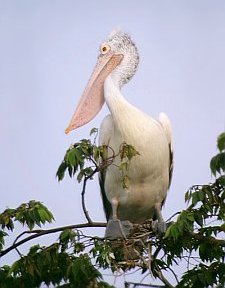|
| Query: bird | Result: 2665th of 32675 | |
Spot-billed Pelican (Pelecanus philippensis) - wiki
| Subject: | Spot-billed Pelican (Pelecanus philippensis) - wiki
| |

| Resolution: 225x288
File Size: 18990 Bytes
Date: 2004:10:03 17:23:30
Camera: Canon EOS 10D (Canon)
F number: f/5.6
Exposure: 1/250 sec
Focal Length: 300/1
Upload Date: 2007:08:20 08:17:19
|
Spot-billed Pelican
From Wikipedia, the free encyclopedia
[Photo] Spot billed pelican. Photograph by Kousik Nandy. Date Dec 19, 2004
The Spot-billed Pelican (Pelecanus philippensis) is a member of the pelican family. It breeds in southern Asia from India to Indonesia. It is a bird of large inland and coastal waters, especially shallow lakes. The nest is a heap of vegetation in a tree. Three to four eggs is the usual clutch size.
The Spot-billed Pelican is a small pelican, at 125-150 cm (49-60 in) long and a weight of 6 kg (13.2 lbs). It is mainly white, with a grey crest, hindneck and tail. In breeding plumage, there is a pink tone to the rump and underwings. Non-breeders are off-white in these areas, and immature birds are more extensively brown. As the species' name implies, there are grey spots on the pink bill in the breeding season.
The Spot-billed Pelican is sedentary resident with local movements and is distributed more widely in the non-breeding season. Like most other pelicans, it catches fish in its huge bill pouch while swimming at the surface.
Due to ongoing habitat lost and human disturbances, the Spot-billed Pelican was evaluated as Vulnerable on the IUCN Red List of Threatened Species. In 2007 it was downgraded to Near Threatened, owing to protection and increased knowledge.
http://en.wikipedia.org/wiki/Spot-billed_Pelican
| The text in this page is based on the copyrighted Wikipedia article shown in above URL. It is used under the GNU Free Documentation License. You may redistribute it, verbatim or modified, providing that you comply with the terms of the GFDL. |
|
^o^
Animal Pictures Archive for smart phones
^o^
|
|

